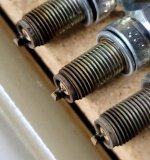RT 1330 Spark plug changeout. Part 2
Now remove the intake manifold adapter. Loosen the metal hose clamp and cut the plastic one. I replaced the plastic hose clamps with metal 4" hose clamps.
View attachment 165322
Now you can pull the secondary air box out. It comes out pretty easy. What you'll see then is the top of the engine!
View attachment 165321
I used a short flat blade screwdriver to disconnect the harness connectors from the ignition coils. The screwdriver lifts the lock tab and pushes the connector back. A lot easier than bare hands! Be careful to not drop the screwdriver! I did! It took me a 1/2 hour to recover it from on the bottom belly pan!
View attachment 165318
Make sure the top of the engine is
clean! You don't want to take a chance on dropping crud into the cylinder! Remove the ignition coils. There are rubber seals at the top of the coils. One or two may stay stuck in the valve cover so make sure you get them back onto the coils. Anyway, don't lose any of them! Don't lose the screws. You may never find them again!
To remove the plugs I used a 3/8" drive spark plug socket and 2 3" extensions.
View attachment 165319
As you can see the plugs are down deep! After getting them loose I took the ratchet off and pulled the plug and tool up a bit and took off the upper extension. The headroom is limited so you aren't going to be able to use a longer extension.
View attachment 165320
When you install the new plugs be sure to use thermal grease on them. Then tighten them to something close to 15 newton-meters of torque. The service manual states 13.5 +/- 1.5 N-m. 15 was easy to see on my torque wrench. The manual refers to the torque as "Retaining Screw Torque". On the NGK web site I found the torque listed at around 10 N-m so I determined retaining screw meant the spark plug thread. Just another glitch in translating from French to English.
Everything goes back together in reverse order of taking it apart!
After you have the harnesses all connected and the air boxes back in you can start the engine. Be ready to be SHOCKED. With all the panels off the 1330 clatters as loudly as a diesel truck engine. I wondered if something was broken, but it wasn't!

